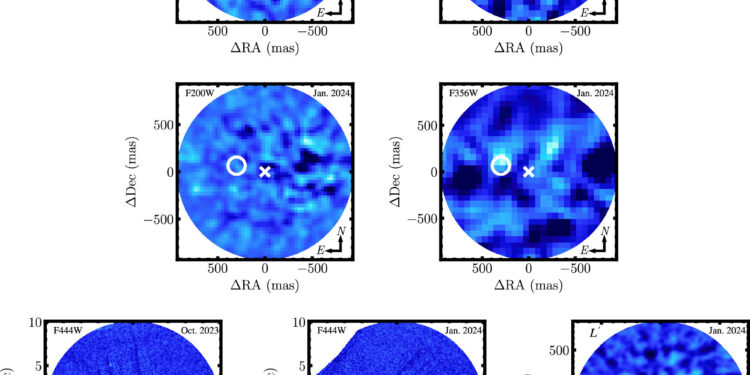Top and middle: F200W (left) and F356W (right) imagery from AF Lep. AF Lep b is not recovered robustly (> 5σ) neither in the filter nor in the epoch. Each image is convolved with a Gaussian filter with a standard deviation of 1 pixel. The circles indicate the expected position of AF Lep b at each epoch. The misalignment between the coronographic mask and the host star for each data set is incorporated into this prediction. Bottom: Left and middle panels show full-frame F444W imagery from AF Lep for each sequence. No significant point sources are observed at wider separations in this imagery. The artifact located northeast of the star in the October 2023 imagery is a cosmic ray artifact that does not appear in the January 2024 imagery. The right panel shows our new Keck/NIRC2 imagery The by AF Lep b. To smooth pixel-to-pixel noise, the image is convolved with a Gaussian filter with a standard deviation of 1.5 pixels. The circle highlights the expected position of the planet. AF Lep b is recovered at an S/N of 6.6σ. Credit: Letters from the astrophysical journal (2024). DOI: 10.3847/2041-8213/ad736a
Planet AF Lep b is a world of firsts. As of 2023, it was the lowest mass planet outside our solar system to be directly observed and whose mass was measured astrometrically. This is a technique that tracks the subtle movements of a host star over several years to obtain information about its orbiting companions, including planets.
AF Lep b is now the lowest mass planet with the smallest angular separation (i.e. its proximity to its host star as seen from Earth) that has been directly observed by the James Webb Space Telescope (JWST ). The results were recently published in Letters from the astrophysical journal.
At 23 million years old, AF Lep b is a relatively young gas giant. (For comparison, Jupiter is 4.6 billion years old.) This makes it bright and therefore a great candidate to observe. However, the team that wanted to learn more about the planet, led by graduate students Kyle Franson of the University of Texas at Austin and William Balmer of Johns Hopkins University, had to race against time to capture it . This is because it is getting closer to its host star in its orbit. The closer we get, the more difficult it will be to observe it.
“AF Lep b is at the limit of detection. Although it is extraordinarily sensitive, JWST is smaller than our largest ground-based telescopes,” Franson explained. “And we’re observing at longer wavelengths, which has the effect of making objects appear fuzzier. It becomes difficult to separate one source from the other when they appear so close together. “
Additionally, JWST uses a coronagraph to observe planets close to their stars. This is a tool that blocks starlight so that nearby objects can be seen. At the angular separation of AF Lep b from its star, the coronagraph blocks more than 90% of the planet’s light. As the planet gets closer to its star, more and more light will be blocked.
“Conventional wisdom has it that JWST is more sensitive to low-mass planets in wide orbits than ground-based installations, but before launch it was unclear whether it would be competitive at small separations,” Brendan said Bowler, an astronomer at UT and co-author of the study. “We’re really pushing the instrumentation to its limits here.”
AF Lep b takes about 25 years to orbit its star. Although in theory astronomers could capture an image of it on the other side of the star when it becomes visible again, it could take more than a decade before that becomes a possibility.
To ensure this opportunity was not missed, the team requested – and received – discretionary time from the director. This is time spent on the telescope that is reserved for critical and urgent observations. It is competitive for proposals to benefit from observing time on JWST, and even more so under this special designation.
“This is the first graduate student-led director’s discretionary time program,” Bowler said. “And it’s one of the few in the exoplanet field.”
“It’s quite something that two graduate students are able to exploit all of these incredible technological innovations,” added Laurent Pueyo, an astronomer at the Space Telescope Science Institute and co-author of the paper.
The team was eager to learn more about AF Lep b’s atmosphere, because it is rare to directly observe planets of similar mass to the gas giants in our own solar system. According to their observations, it has a very active atmosphere, with convection currents mixing elements between its lower and upper levels.
“We observed a lot more carbon monoxide than initially expected,” Balmer explained. “The only way to introduce this type of gas into the planet’s upper atmosphere is through strong updrafts.”
While it is exciting to learn more about AF Lep b, the ability to make these observations is particularly remarkable.
“Overall, this data was collected during JWST’s second year of operation. There is much more to come,” Bowler said. “It’s not just about the planets we know about now. It’s also about the planets we’ll soon discover. This foreshadows some of the exciting work we’ll see in the years to come.”
More information:
Kyle Franson et al, JWST/NIRCam 4–5 μm imaging of the giant planet AF Lep b, Letters from the astrophysical journal (2024). DOI: 10.3847/2041-8213/ad736a
Provided by the University of Texas at Austin
Quote: Astronomers race to capture image of exoplanet near a star (October 9, 2024) retrieved October 9, 2024 from
This document is subject to copyright. Except for fair use for private study or research purposes, no part may be reproduced without written permission. The content is provided for informational purposes only.



